Review: Nauticam 140mm dome port by Alex Mustard
Nauticam 140mm Dome
By Alex Mustard.
I was keen to try Nauticam’s new 140 (5½”) glass dome because it looks like a quality product and is, in my mind, the smallest size dome I would consider acceptable on full frame. So I arranged to borrow one as part of my Nikon D750 review. The dome is so similar in size and shape to my own FX-mini dome that I was confident enough to travel with just this dome to the Red Sea to complete the camera review.
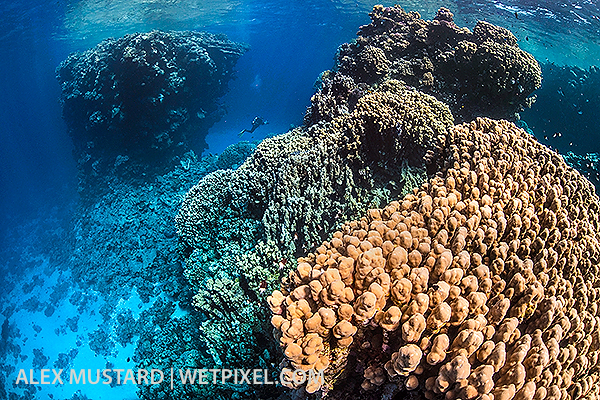
You can attached smaller domes onto a full frame camera housing, but their use is very compromised. Many people have tried to use 100mm mini domes (5) on Nikon FX cameras, but neither fisheye lens (Sigma 15mm or Nikon 16mm) is easily suited. The Nikon 16mm has a minimum focus distance (from the sensor) of 0.25mm, and as a result struggles to bring the virtual image created by the 100mm dome into focus (as it is closer to the dome than the virtual image created by a big dome). In fact, the 16mm Nikkor can only focus on more distant underwater subjects behind such a small dome (the opposite of one of the main motivations for using a minidome).
The Sigma 15mm can focus close enough for the 100mm minidome, but has too large a lens shade to fit inside it. One solution is to shave the hood off. Adam Hanlon was brave enough to shave his 15mm and lent it to me when I was shooting the D800 in the Red Sea in 2012. The shaved lens fits and focuses inside a 100mm dome, but the corner sharpness is not up to a quality that I would recommend for everyday shooting, especially as you probably invested in an FX camera for its superior image quality (6) (see the photo of the snappers in the previous section).
The larger 140 dome gives enough room to use the Sigma 15mm without shaving off the lens hood! It also produces a more distant and less steeply curved virtual image than a 100mm dome, which improves corner sharpness in the final image. I chose to take three lens combos to test it with: the Sigma 15mm fisheye, the Sigma 15mm fisheye with 1.4x teleconverter and the non-fisheye Tokina 17mm rectilinear(7). The first two options I expected to work well with the dome, the last I felt would be a challenge. I used the fisheye TC converter with a 20mm port extension and the Tokina 17mm with a 30mm port extension.
Rectilinear lenses are less forgiving behind domes than fisheyes and smaller domes exacerbate the corner issues. Adam has tried almost all the rectilinear wide angle options for Nikon FX and reckoned if anything would work, then it would be the Tokina 17mm. In other words, you can view the Tokina 17mm as a best case for rectilinear lenses behind the 140mm dome!
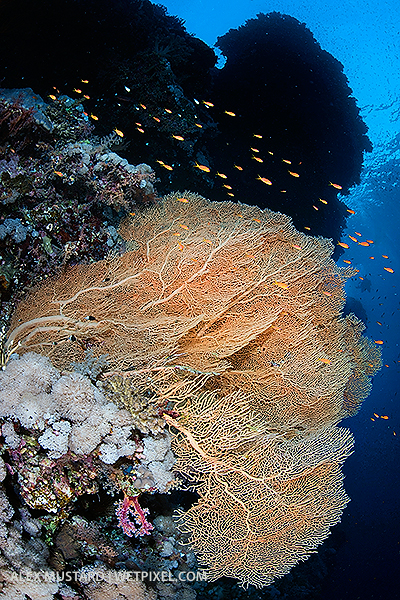
The Sigma 15mm lens performed very well behind the 140mm dome, although wherever possible I kept the aperture between f/14-f/16 to ensure acceptable quality in the corners. In normal reef scenic shooting this was easy to achieve with a little boost in strobe power. At f/14 the extreme corners of the frame are a little soft, but this is away from the main subject matter and I can’t believe anyone would reject the photo as a result.
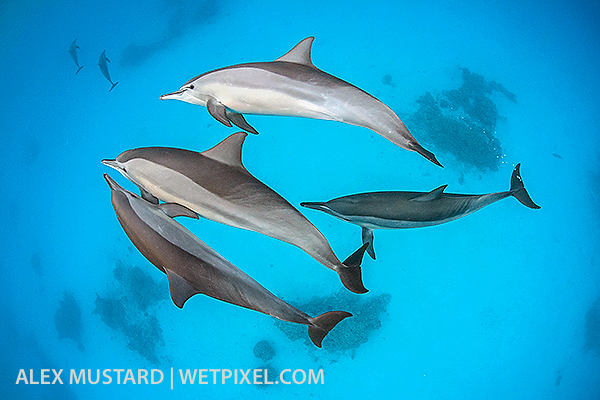
On two occasions I was forced to shoot more open apertures because light was limiting (I was not using strobes). On these occasions the lack of sharpness in the corners is evident, but the images still succeed because this loss of sharpness is not critical with the particular subject matter. In the dark caverns I ended up at f/5.6 and rock formations in the corners of the frame are blurred, but it does not ruin the shot. With the dolphins in the blue, I was shooting on f/6.3 and the corners are again not sharp, but blurry blue water looks rather similar to in focus blue water!



I took my Kenko 1.4x teleconverter to use with the Sigma 15mm to give me lens combo with a narrower angle of view, but one that still retained fisheye properties and therefore would work well with the 140 dome. A full frame rectilinear lens of the same angle of view (approx. 100˚) would be expected to struggle behind a small dome.
The fisheye TC combo did work well behind the dome and it was my choice for 5 of the 7 dives where I hoped to see (and did see) oceanic whitetip sharks. While waiting for sharks I shot some reef scenery with this setup and in these brief tests found the corner sharpness was acceptable over a similar range as with the straight fisheye. I tried to keep the lens stopped to at least f/14 and shut it down further when I could.
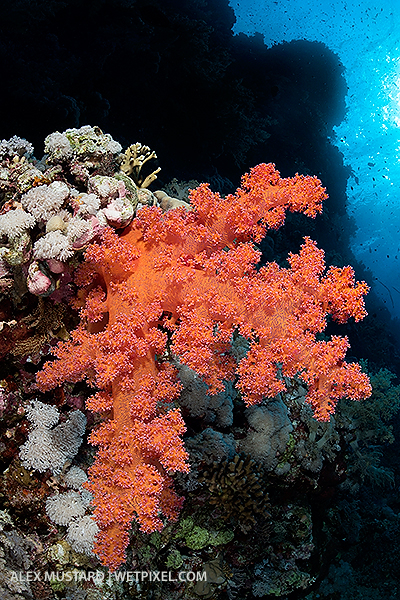
However, when big animal shooting (oceanic whitetip sharks) I usually had to open the aperture a little more (f/10-f/14) as I didn’t want to turn my strobes up too high, to allow a good rate of frames from a pass. The corners of the frame were now blue water and free of detail, so remained acceptably sharp. I am pleased with the results but would like to do further testing to more precisely determine the limits of the fisheye TC combo on more repeatable subject matter!

I was reluctant to “waste” a dive with Adam’s Tokina 17mm behind the 140 dome on such a short trip, since my expectation was poor performance. In fact, when I jumped in with the 17mm and met an oceanic right under the boat, I considered surfacing immediately and changing to the fisheye TC. But to my surprise the combination worked providing it was kept stopped down to f/18-f/22. With modern SLRs it is relatively easy to bump the ISO up a bit to allow you to shoot at very small apertures8. It is not perfect (and at apertures wider than f/11 it is really unusable, and fussy photographers would place the threshold at f/14), but better than I was expecting. Although the bottom line is that once I had done my test shots, I didn’t fancy using it again on the trip!

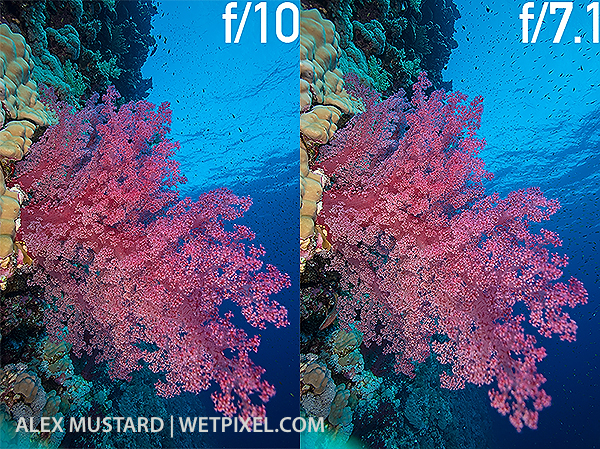

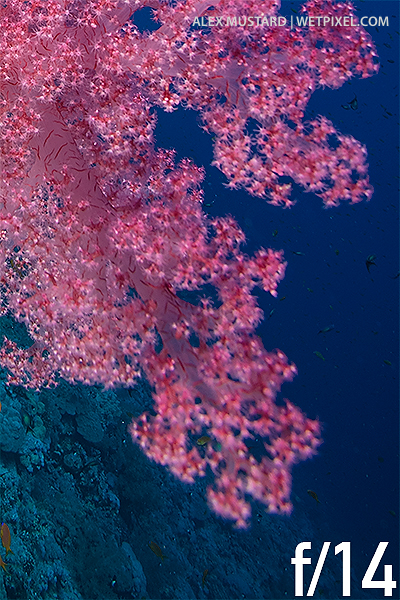


From tests with my own dome I am sure that the Nikon 16mm fisheye would be compromised with the Nauticam 140 simply because it cannot focus close enough. The situation is not as severe as with a 100mm dome, but I would still expect to have to back off some subjects with the 16mm behind the 140 dome just to bring them into focus.
My favourite rectilinear lens underwater (not on land) is the Nikon 16-35mm because it performs better behind a dome than Nikon’s other FX rectilinear wide angles. I didn’t try this lens with the 140 dome, but I would expect it to perform no better, and probably worse, than the Tokina 17mm. Other rectilinear lenses would be worse still.
Finally, like on almost all mini-domes, the neoprene cover for the Nauticam 140 is great at protecting the dome, until you take it out of its box and put it on the camera. Then it falls off continuously (gust of wind, boat rocking etc!). Neoprene covers rarely work with minidomes and manufacturers should supply them with rigid plastic protective covers.
Notes on this section:
(5) Many crop sensor users have discovered that 100mm domes work very pleasingly with the 10-17mm Tokina fisheye. But when they move to full frame cameras they find the dome difficult to use.
(6) Adam now uses a Zen 170mmm as his FX minidome of choice, with an unshaved Sigma 15mm.
(7) Kindly lent by Adam again. Adam has been using this lens for a while and reckons it is one of the best non-fisheye, ultra-wide lens options for full frame underwater photography. When we dived together on the Bahamas Underwater Photo Week assignment in May, I was very impressed with the results he was getting with it behind the Zen 170 (a small dome for a rectilinear FX lens). Adam suggested I take it as the rectilinear lens most likely to work behind the 140mm dome, although neither of us was expecting great success.
(8) As long as the ambient light is not too strong, at which point turning up the ISO is not helpful as you run out of shutter speed.
Conclusion
The Nauticam 140 dome is a quality product, travel friendly and produces high quality results with the Sigma 15mm fisheye and with this fisheye fitted with a teleconverter (when a narrower angle of view is required). With an FX camera (and these lenses), I would still advise keeping lenses stopped down to at least f/14. Where this is not possible, I would advise keeping important subject matter away from the corners of the frame.
Other F-mount wide angle lenses are not so suitable with a 140mm dome, although they can be used as long as the photographer considers the significant compromises (focus, depth of field) involved and adjusts their technique and composition to accommodate.
The 140 is the smallest dome I would recommend using with Nikon FX cameras underwater, and when used correctly yields very pleasing image quality in all types of wide angle, enabling FX shooters to travel lighter and get their lenses and lighting closer to their subjects for extreme CFWA and WAM shots, not possible with large domes.
Page 1. Overview of dome ports.
Page 2. Review of Nauticam 140mm dome port.